Thirteen-year-old Lesly built camps using hair ribbons to keep her three younger siblings safe while they were lost in the Amazon jungle for six weeks – as her aunt and grandmother tell of their pride.
The children, Lesly, 13, Soleiny, nine, Tien Noriel, four, and baby Cristin had been travelling in a light aircraft on May 1 when it crashed. The accident killed everyone else on board, the children’s mother Magdalena Mucutui Valencia, the pilot and an indigenous leader.
Officials in the South American country announced their rescue on Friday, bringing a happy ending to a saga with highs and lows as searchers frantically combed through the rainforest hunting for the youngsters.
The aunt of the four children said a ‘survival game’ they played must have prepared them for the ordeal.
Damarys Mucutuy told the Caracol news network that the thirteen and nine-year-old would frequently play the game before their time in the jungle. ‘When we played, we set up like little camps,’ she said.
Lesly, the eldest, ‘knew what fruits she can’t eat because there are many poisonous fruits in the forest. And she knew how to take care of a baby,’ the aunt added.
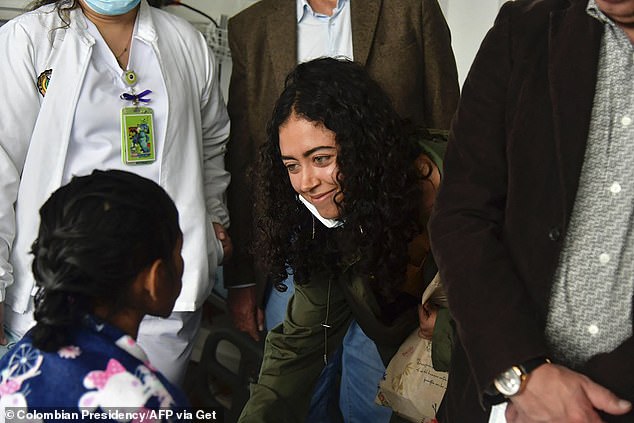
Sofia Petro, daughter of Colombian President Gustavo Petro, greeting Lesly (seen with her back to camera) as she recovers in hospital in Bogota
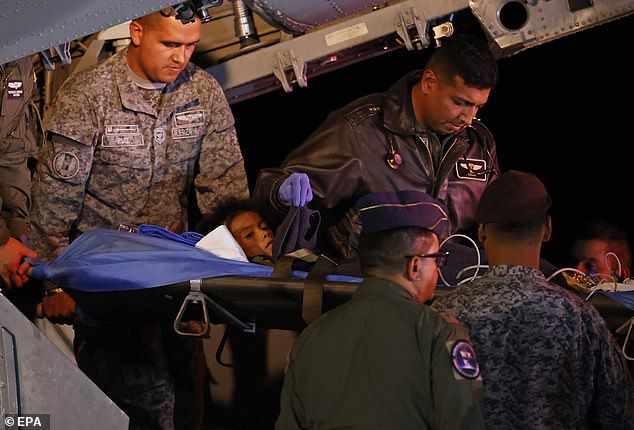
The eldest of the four Columbian children who survived 40 days in the Amazon jungle is a thirteen-year-old girl who looked after her youngersiblings
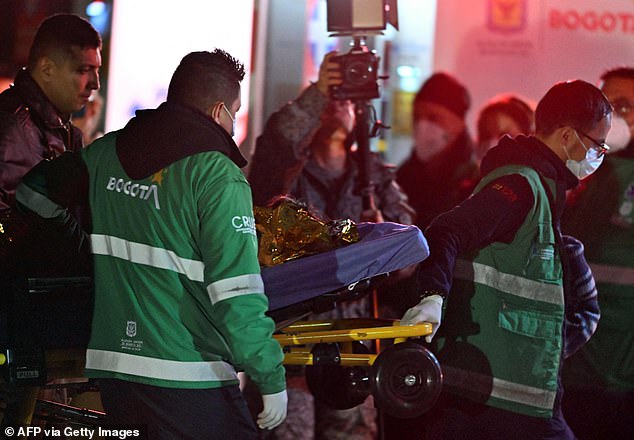
Military personnel unload from a plane one of four children who were missing after a plane crash at CATAM Military Airport in Bogota

Officials in the South American country announced their rescue Friday, bringing a happy ending to a saga with highs and lows as searchers frantically combed through the rainforest hunting for the youngsters
The children’s grandfather Fidencio Valencia said they were ‘very weak’ but ‘happy to see their family’.
In photographs released by the military, hair ties could be seen among branches on the jungle floor.
The children’s grandmother, Fatima Valencia, said after the rescue: ‘I am very grateful, and to mother earth as well, that they were set free.’
She explained the eldest of the four was used to looking after the other three when their mother was at work, and this helped them survive in the jungle
‘She gave them flour and cassava bread, any fruit in the bush, they know what they must consume,’ Ms Valencia said.
‘They were raised by their grandmother,’ said John Moreno, a leader of the Guanano group in Vaupes, in the southeastern part of Colombia where the children were raised.
‘They used what they learned in the community, relied on their ancestral knowledge in order to survive.’
Now the children have received treatment at a military hospital in the capital, Bogota.

President Gustavo Petro greeted a nurse tending to one of the four Indigenous children who survived an Amazon plane crash
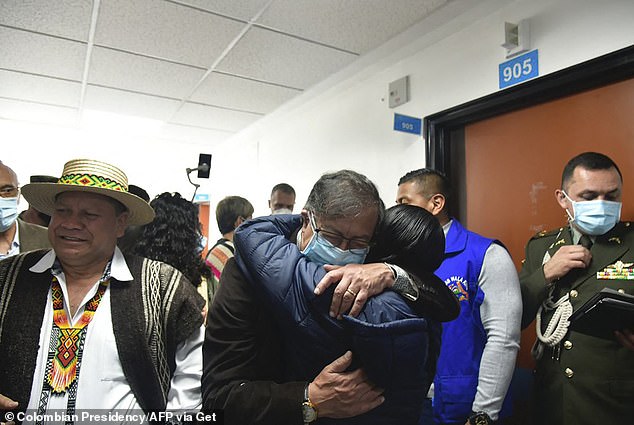
Colombian President Gustavo Petro (centre) embraced a relative of the four Indigenous children who were found alive
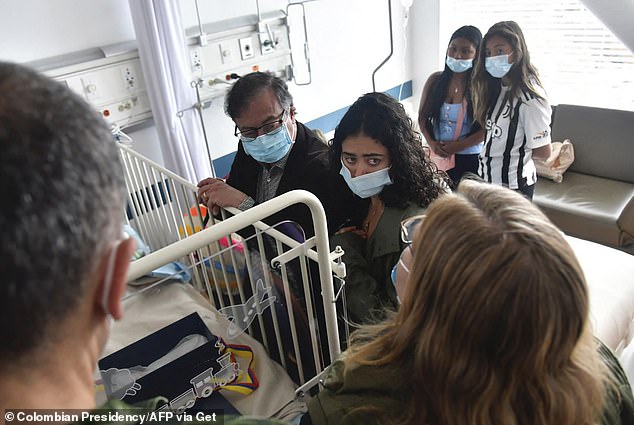
Petro and his daughter Sofia Petro visited one of the four Indigenous children
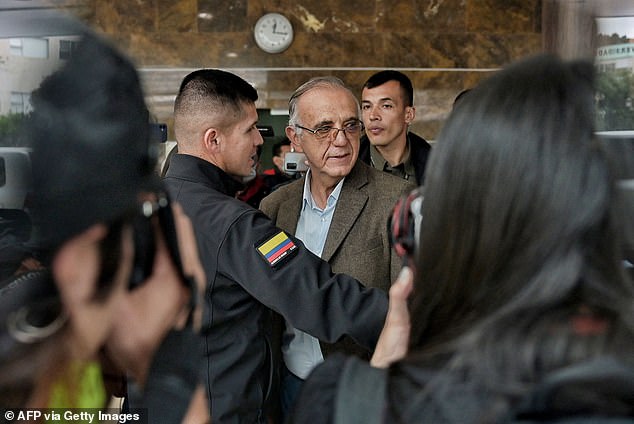
Colombian Minister of Defense Ivan Velasquez (C) leaves after speaking to the media at the Military Hospital
After the siblings were found alive army radios could be heard saying: ‘Miracle, miracle, miracle, miracle’ – the army code for a child found alive and repeated four times to reflect all four children.
President Gustavo Petro celebrated the news upon returning from Cuba, where he signed a cease-fire with representatives of the National Liberation Army rebel group.
Petro called them an ‘example of survival’ and predicted their saga ‘will remain in history.’
Colombia’s Defence Minister Ivan Velasquez, said: ‘It is thanks to [Lesly], her value and her leadership, that the three others were able to survive, with her care, her knowledge of the jungle.
‘In general the children, the boy and the girls are in an acceptable state, according to the medical reports they are out of danger.’
Military doctor Carlos Rincon said while the children have ‘nutritional deficiencies’ they only survived with only ‘some soft tissue injuries, bites, and skin lesions’.
He added: ‘We will begin the process of incorporating food when we complete the process of clinical examinations that will be done today.
‘If things go well, we believe they will stay in the hospital for two to three weeks.’
Astrid Caceres, the general director of the Colombian Institute of Family Welfare, said the children were not talking as much as officials would like and they still need time to recover.
Damaris Mucutuy, an aunt of the children, told a radio station that ‘the children are fine’ despite being found with signs of dehydration and insect bites.
Mucutuy, who arrived at the hospital at dawn yesterday with other family members, said the children had been offered mental health services.
‘The jungle saved them’ Petro said. ‘They are children of the jungle, and now they are also children of Colombia.’
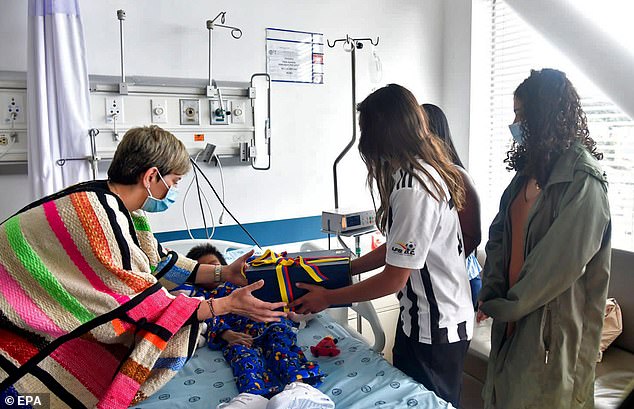
Today the children have received treatment at a military hospital in the capital, Bogota
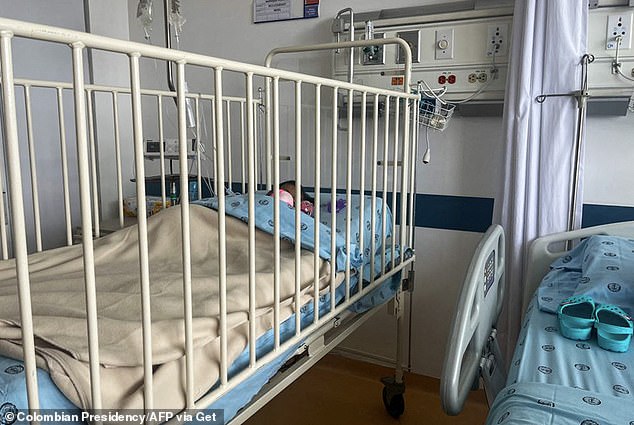
One of the children is lying in a cot in hospital after surviving in the jungle for 40 days
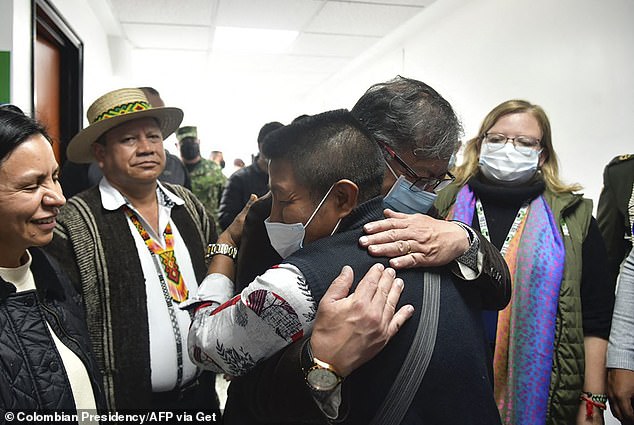
Colombian Presidency shows Colombian President Gustavo Petro (back) embracing Fidencio Valencia, the grandfather of the four Indigenous children
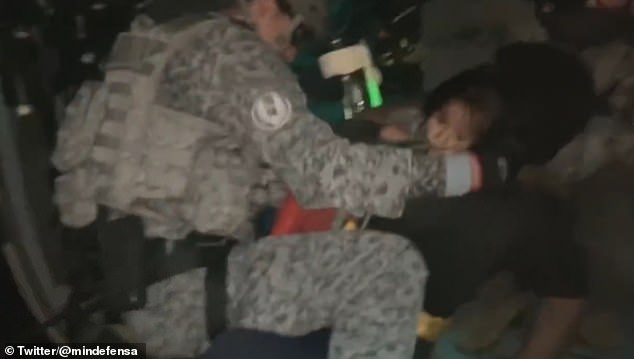
Helicopter crew carefully winched the young children, who were dehydrated, bitten and malnourished but otherwise unharmed, on board
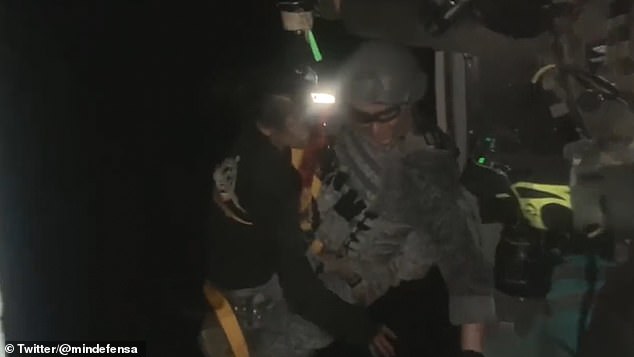
The four children had been in a plane crash, which killed all the adults on board, on May 1 and had survived alone in the Amazon since

The children were airlifted to safety by an army helicopter after finally being located in the jungle
When the wreckage of the plane was found after weeks of hunting not only were the children not found dead alongside the adults, there was part-eaten fruit that suggested they had all survived.
That sparked a huge hunt across miles of dense and remote Amazon rainforest and the President, Gustavo Petro, mistakenly caused false hope when he said they were safe only to retract his statement and say there was just evidence they might still be alive.
After they were miraculously found, dramatic footage shows how the four children were winched into a rescue helicopter, bitten, dehydrated and malnourished but mercifully alive, and taken to safety for medical treatment.
But the rescue efforts intensified and he delivered the news the country, and the watching world, had hoped for.
‘It is a joy for the whole country,’ Petro Tweeted.
‘They were alone, they themselves achieved an example of total survival which will remain in history.’
The siblings, members of the Huitoto Indigenous group, are dehydrated, malnourished and bitten by insects but are otherwise healthy, rescuers said.
Their grandmother, whose voice was played from aircraft above the jungle during the search to reassure the youngsters they were being looked for, told reporters: ‘I never lost hope, I was always supporting the search. I feel very happy, I thank President Petro and my ‘countrymen’ who went through so many difficulties.’
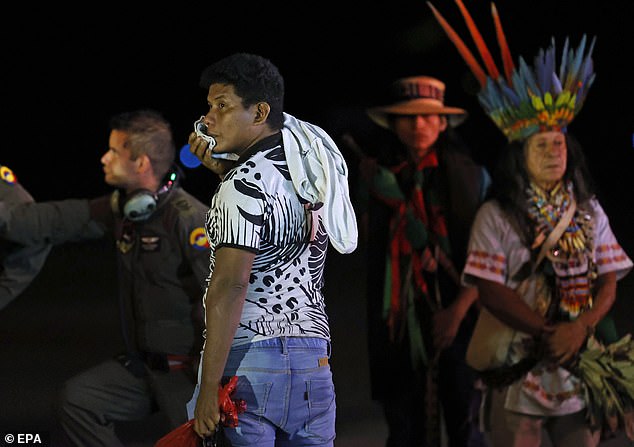
The children’s father, Manuel Ranoque (in black and white), waits on the tarmac as his children are stretchered from the plane
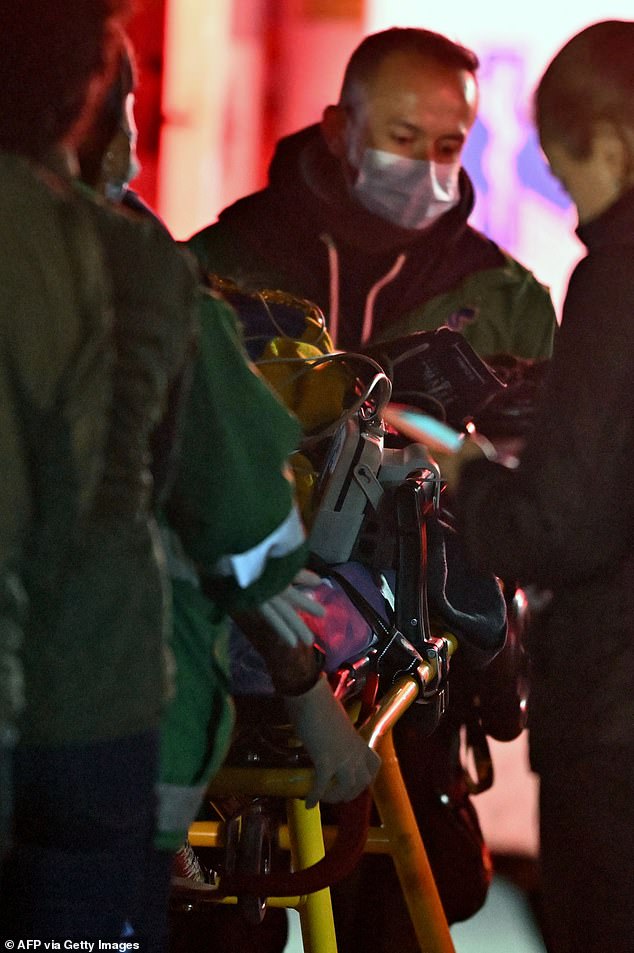
One of the children is carefully taken by medics to an awaiting ambulance to receive treatment
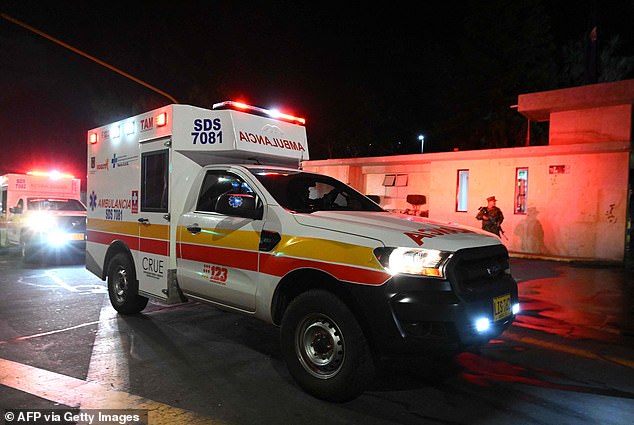
Ambulances transporting the four Indigenous children who were found alive after being lost for 40 days
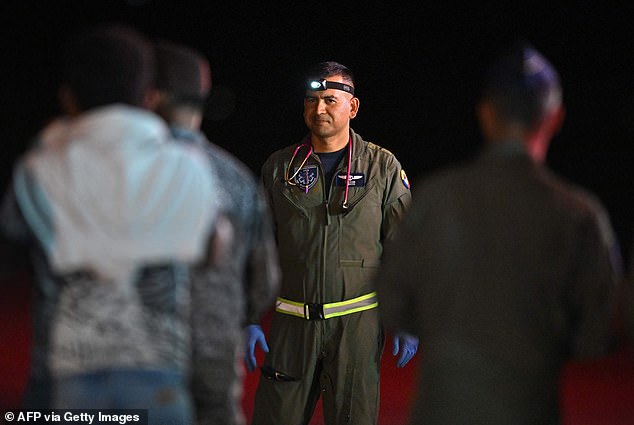
A military doctor waits for the four indigenous children who were found alive but suffered dehydration and malnourishment during their time in the jungle
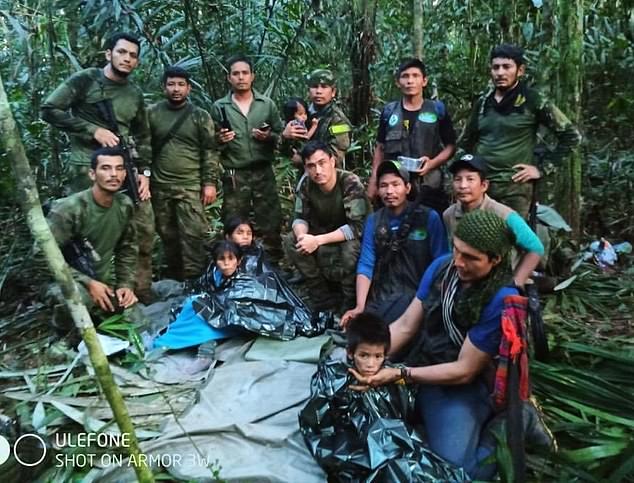
Four indigenous children (pictured) who went missing for six weeks in the Colombian Amazon jungle after a plane crash have been found alive
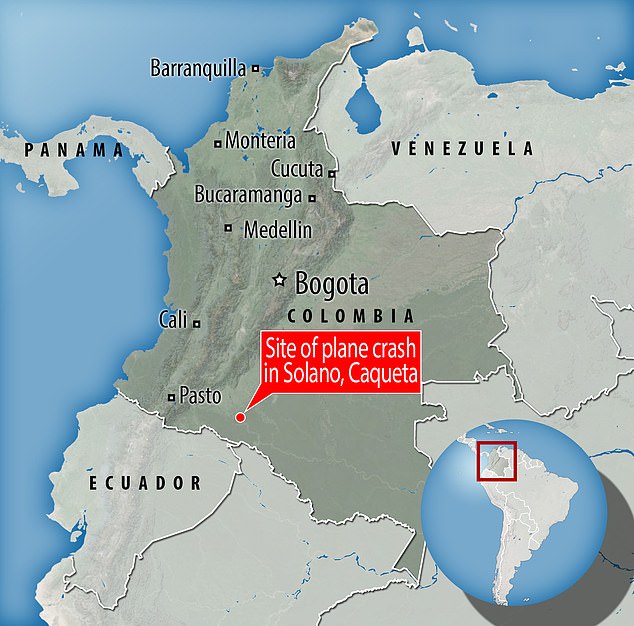
The plane crash happened in Solano, Caqueta. The aircraft was found destroyed on May 16
Overnight an army helicopter hovered above the tree canopy, hoisted the four on board and flew them to hospital for checks. The delighted soldiers had earlier posed for photographs with the children, who appeared emaciated.
After their discovery, the children were treated by medics from the Special Operations Command deployed in the area and then transferred by helicopter to the military base of San Jose del Guaviare, where they were stabilised.
The children’s grandfather told Noticias Caracol he was very grateful to the army for helping to find them, adding ‘I want to see them’.
The survival story is all the more miraculous as the jungle is home to jaguars, pumas, snakes and other predators, as well as armed groups that smuggle drugs and terrorize local populations.
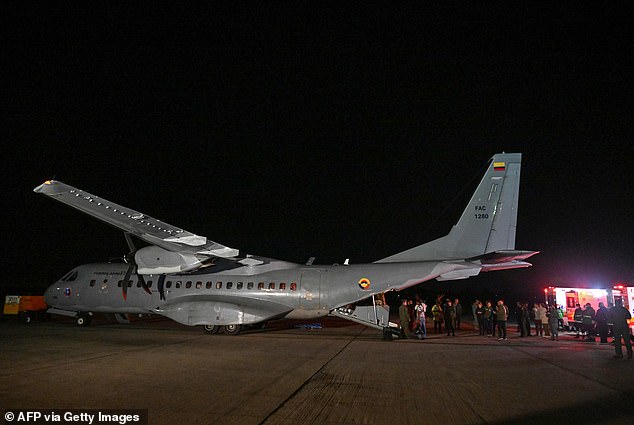
Ambulances wait for the children, who were dehydrated and malnourished but otherwise remarkably healthy, to disembark the plane
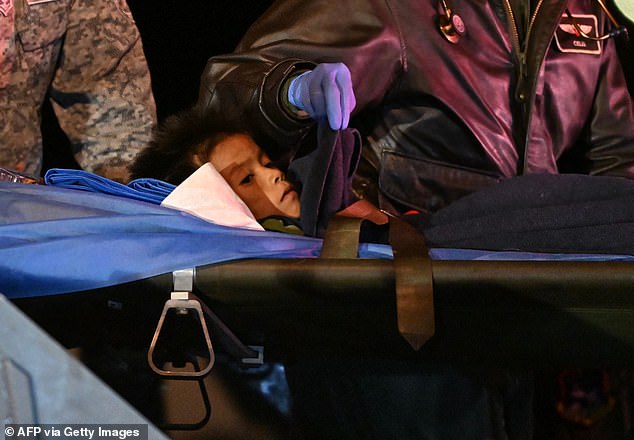
One of the four Indigenous children who were found alive after being lost for 40 days in the Colombian Amazon is stretchered from the plane
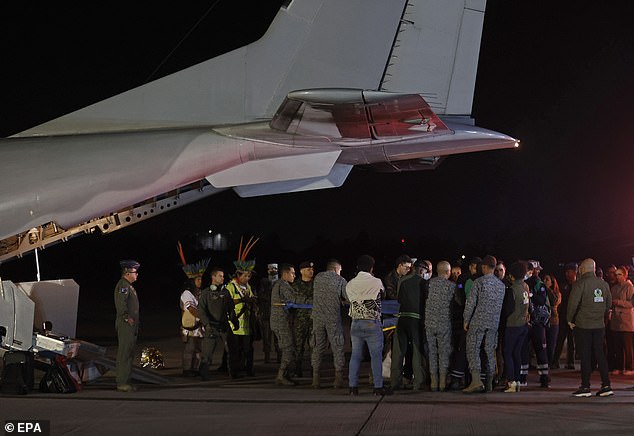
Tribal leaders, military personnel and the children’s father wait on the tarmac for the children to be stretchered from the plane
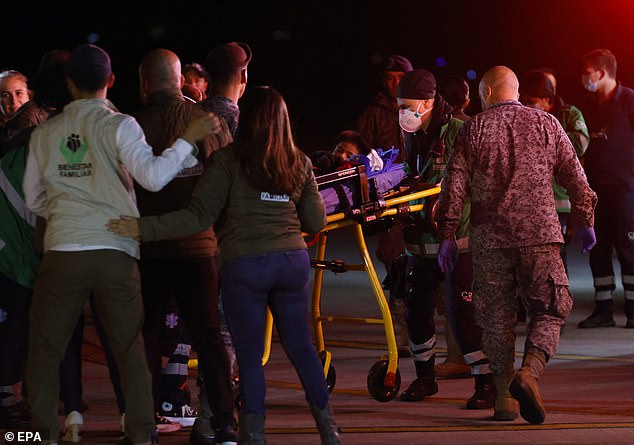
After their discovery, the children were treated by medics from the Special Operations Command deployed in the area and then transferred by helicopter to the military base of San Jose del Guaviare
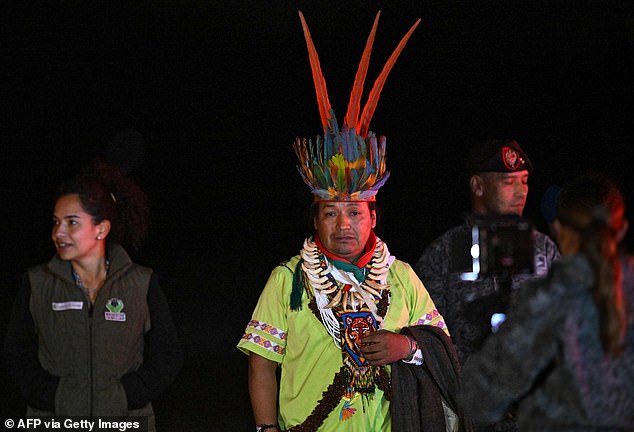
An Indigenous man who took part with the military in the search of the four children stands by the plane as the children arrive
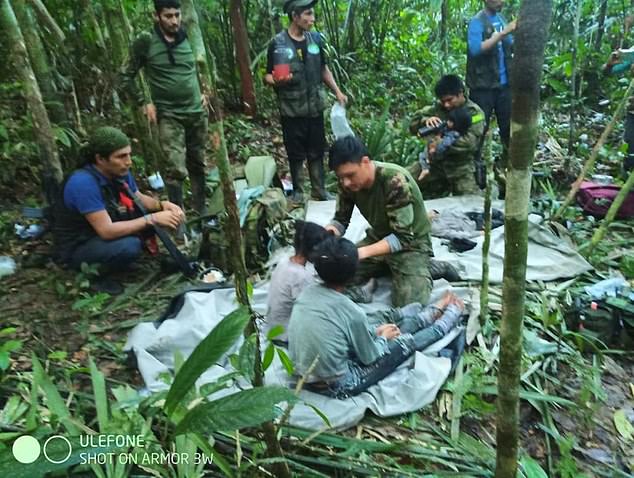
The children had been missing for more than a month, sparking a massive search operation to find them

The crash is believed to have happened due a mechanical failure on May 1. The wreckage was found wedged in thick vegetation, having apparently nosedived into the jungle
Defense Minister Ivan Velasquez paid tribute to the various army units’ ‘unshakeable and tireless’ work, as well as to the Indigenous people who took part in the search.
Army rescuers ‘immediately took charge of and stabilised’ the four siblings, who were to be transferred to San Jose del Guaviare, according to the minister.
‘Tomorrow, depending on their medical assessment and condition, we hope they will be transferred to Bogota, to the military hospital,’ Velasquez said.
The drama began to unfold on May 1 when the group caught a routine flight on a Cessna 206 from Araracuara to the town of San Jose del Guaviare. In a country with such dense jungle, light aircraft and boats are often the only viable means of transport.
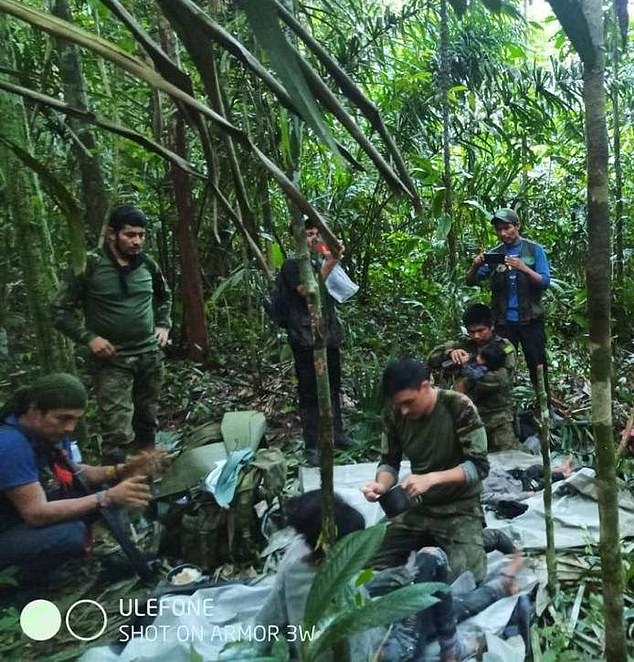
The siblings, aged one, four, nine and 13, had been travelling in a light aircraft on May 1 when it crashed
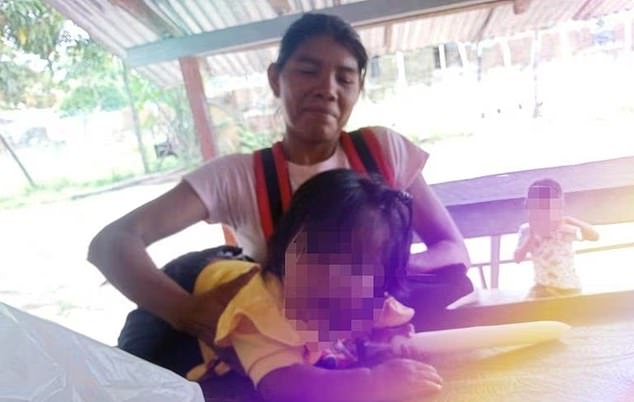
The missing children included four-year-old Tien Noriel Ronoque Mucutuy, pictured here with his mother Magdalena Mucutuy Valencia, who died in the plane crash
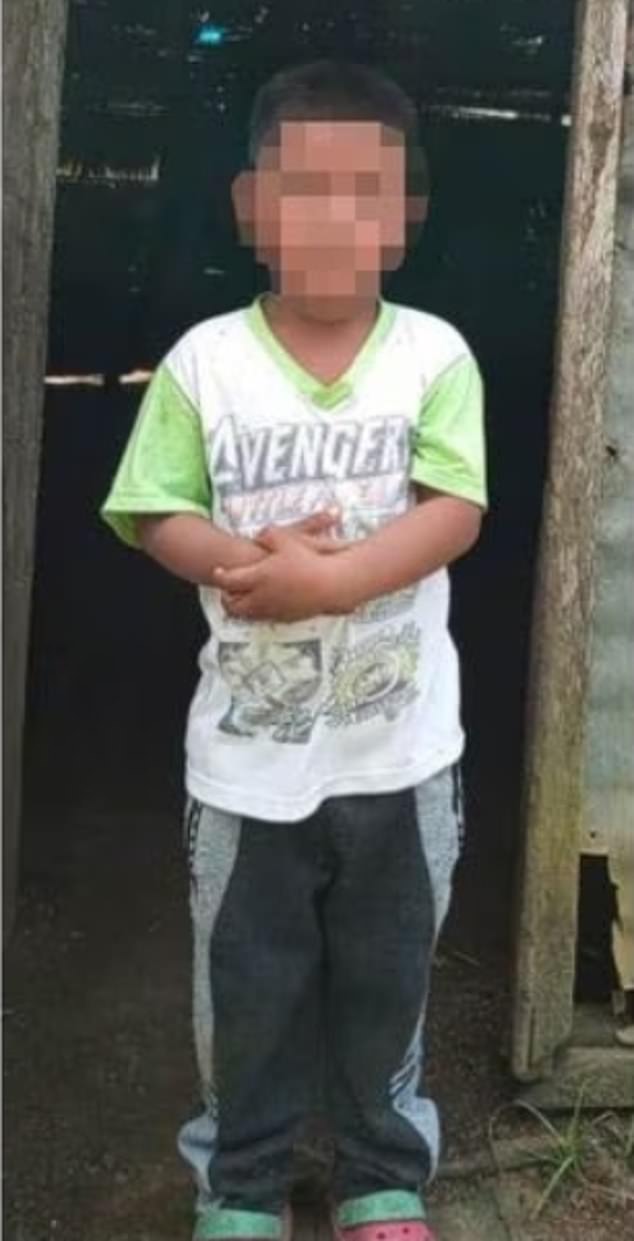
Nine-year-old Soleiny Mucutuy, pictured, was missing in the jungle with his three siblings
Minutes after starting the 350km (220 mile) journey, the pilot reported problems with the engine and the plane disappeared from radars.
Between May 15 and 16, soldiers found the bodies of the three adults and the debris of the plane, which was wedged vertically in the thick vegetation, its nose destroyed.
But the children – Lesly, 13, Soleiny, nine, Tien Noriel, four, and baby Cristin – remained missing.
Some 200 soldiers and indigenous people with knowledge of the terrain have been combing a dense jungle area of some 320 sq km (124 sq mi) – about double the size of Washington DC.
The air force had dumped 10,000 flyers into the forest with instructions in Spanish and the children’s indigenous Huitoto language, telling them to stay put.
The leaflets also included survival tips, and the military has dropped food parcels and bottled water for the children.
Powerful searchlights were shone into the area ‘so that the minors can approach us’, search team member Colonel Fausto Avellaneda told the Noticias Caracol TV show.
Huitoto children learn hunting, fishing and gathering, and the kids’ grandfather, Fidencio Valencia, had said the children are well acquainted with the jungle.
At one point the search team believed it had come to within 100m (300ft) of them, but storms, thick vegetation and marshy terrain prevented them from reaching them.
Members of the indigenous community held traditional ceremonies ‘speaking to the jungle’ and asking it to give up the children.
But the jungle began giving up tantalising clues that hopes were not lost for the youngsters. In photographs released by the military, scissors, shoes, and hair ties could be seen among branches on the jungle floor.
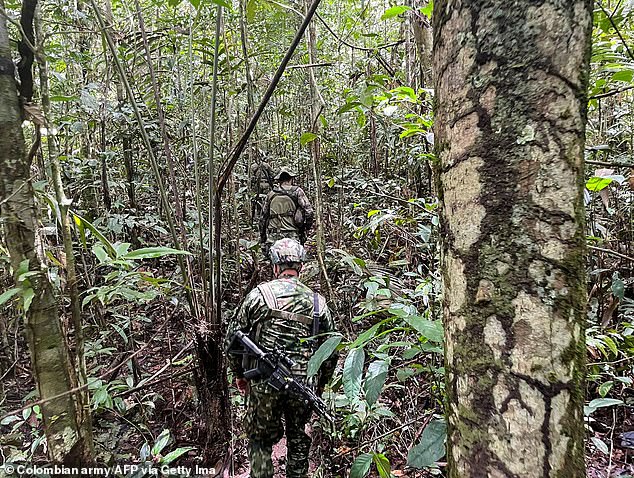
There were no signs of the youngsters when the aircraft’s wreckage was recovered by the Colombian military – causing a huge search operation in the southeast of the country to find them
A picture released by the Colombian army showed a footprint found in the forest in a rural area of the municipality of Solano, Caqueta, in southeastern Colombia
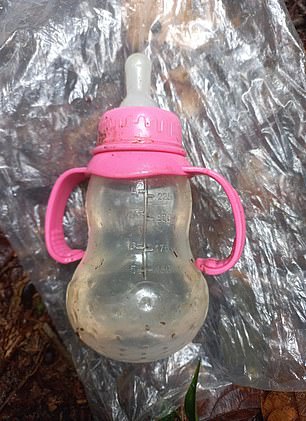
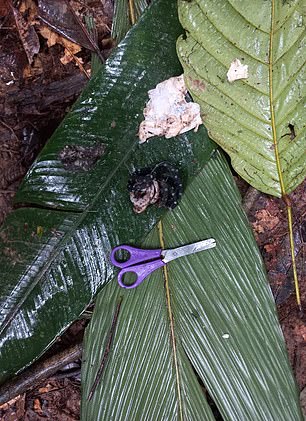
A baby bottle and a pair of scissors were among items the rescuers found which gave them hope of survivors as they searched the jungle for the missing children

More than 100 soldiers with sniffer dogs walked through the jungle in the south of Colombia searching for the missing children
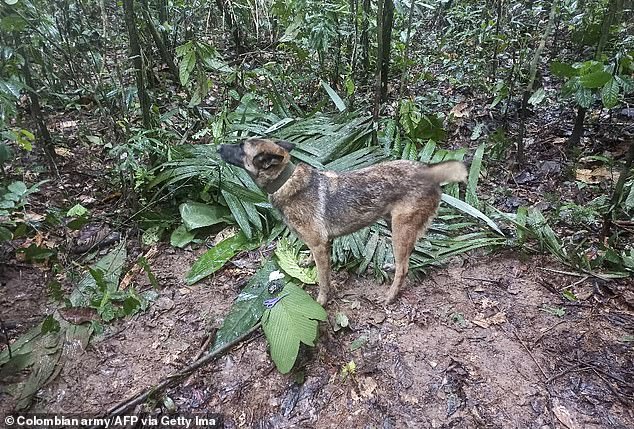
Sniffer dogs and three helicopters were deployed in search of the children, but wild animals, heavy rain and tree height have prolonged the rescue operation
A baby’s drinking bottle and half-eaten pieces of fruit had been spotted before the shelter’s discovery.
Then nearly two weeks ago, a footprint was found on the muddy jungle floor. Army officials believed it to belong to 13-year-old Lesly.
Leaders from the Huitoto indigenous group expressed hope that the children’s knowledge of fruits and jungle survival skills should give them better odds of being found alive.
Boxes of food were dropped to the jungle floor to help sustain the children. And yesterday the efforts paid off when one of the rescue dogs who had been on their scent led soldiers to the group, the President confirmed. They had been following footprints left on the muddy floor.
‘The jungle saved them,’ Petro said. ‘They are children of the jungle, and now they are also children of Colombia.’












